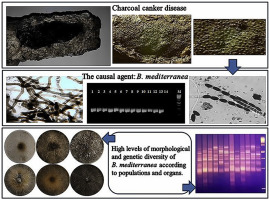Fungal Ecology ( IF 1.9 ) Pub Date : 2019-07-31 , DOI: 10.1016/j.funeco.2019.07.001 Islem Yangui , Meriem Zouaoui Boutiti , Anna Maria Vettraino , Natalia Bruni , Andrea Vannini , Mohamed Lahbib Ben Jamaâ , Mohamed Boussaid , Chokri Messaoud

|
Biscogniauxia mediterranea is a xylariaceous ascomycete responsible for ‘charcoal disease’, the most frequent disease of cork oak in the Mediterranean basin. However, little is known regarding this fungus in North Africa. This is the first report on the morphological and genetic diversity of B. mediterranea populations in Tunisia.
A total of forty-eight isolates from cork oak trees, corresponding to three different sites and three tree parts, were identified as B. mediterranea based on morphological and molecular diagnosis. Variability among the isolates was evaluated using morphological traits and microsatellite-primed PCR (MSP-PCR). B. mediterranea isolates showed high variability in culture, specifically in colony color. A high level of genetic diversity within populations and within tree parts was detected (H = 0.417, I = 0.605, and H = 0.415, I = 0.601 respectively). Significant genetic differentiation among populations (GST = 0.116 and ΦST = 0.137; p < 0.001) was determined. However, a low genetic differentiation among tree parts (GST = 0.066 and ΦST = 0.018; p = 0.07) was observed. Principal coordinate analysis showed that genetic divergence was partially related to the geographical origin. Cluster analysis based on morphological traits showed that the grouping of the isolates occurs independently of the geographic location and the tree part. The effective number of alleles (Ne), the Nei's gene diversity index (H), the Shannon's information index (I), the colony color and the presence of exudates were significantly correlated with the altitude and the rainfall. The number of alleles (Na), the percentage of polymorphic loci (PPL), the texture and the density of the mycelium were significantly correlated with the temperature. These results provide a deeper understanding of population genetics of B. mediterranea and its adaptation to environmental conditions which could help to develop control strategies against charcoal canker disease.
中文翻译:

突尼斯与软橡树栎(栎栎)相关的地中海双歧杆菌:表型变异,遗传多样性与生态因子之间的关系
Biscogniauxia mediterranea是一种木霉菌状的子囊菌,负责“木炭病”,这是地中海盆地最常见的软木橡树病。但是,关于这种真菌在北非知之甚少。这是关于突尼斯双歧杆菌的形态和遗传多样性的第一份报告。
共有来自软木橡树48分离,对应于三个不同的位点和三个树部分,被确定为B.地中海基于形态学和分子诊断。使用形态学特征和微卫星引物PCR(MSP-PCR)评估了分离株之间的变异性。中间芽孢杆菌的分离物在培养中表现出高变异性,特别是在菌落颜色方面。在种群内和树木部分内检测到高水平的遗传多样性(分别为H = 0.417,I = 0.605,H = 0.415,I = 0.601)。种群间显著遗传分化(G ST = 0.116和Φ ST = 0.137; P <0.001)测定。但是,树木部分之间的遗传分化程度较低(G ST = 0.066和Φ ST = 0.018; p = 0.07)。主坐标分析表明,遗传差异与地理起源部分相关。基于形态特征的聚类分析表明,分离株的分组独立于地理位置和树木部分而发生。等位基因的有效数量(Ne),Nei基因多样性指数(H),Shannon信息指数(I),菌落颜色和渗出液的存在与海拔和降雨显着相关。等位基因的数目(Na),多态性位点的百分比(PPL),菌丝的质地和密度与温度显着相关。这些结果使人们更加了解了中间芽孢杆菌的种群遗传学。 以及其对环境条件的适应性,可能有助于制定针对木炭溃疡病的控制策略。











































 京公网安备 11010802027423号
京公网安备 11010802027423号